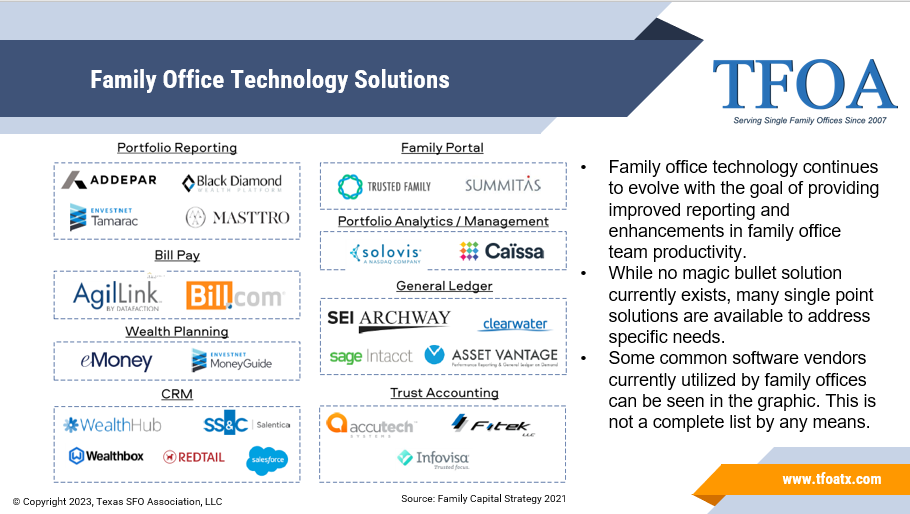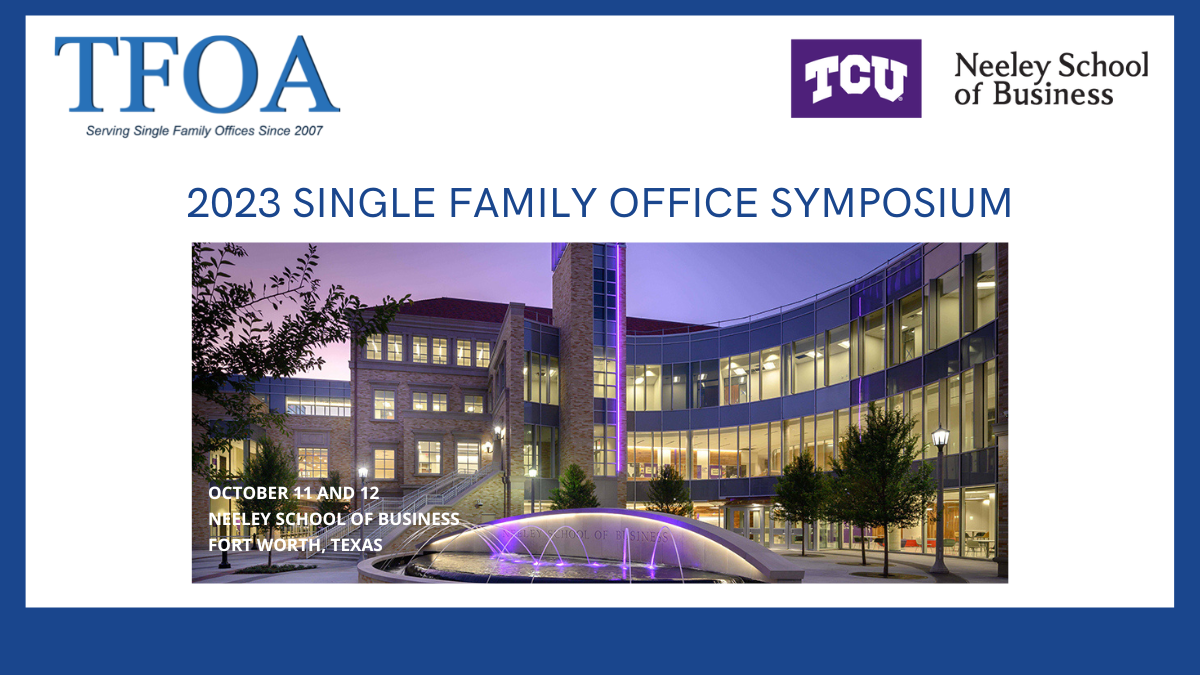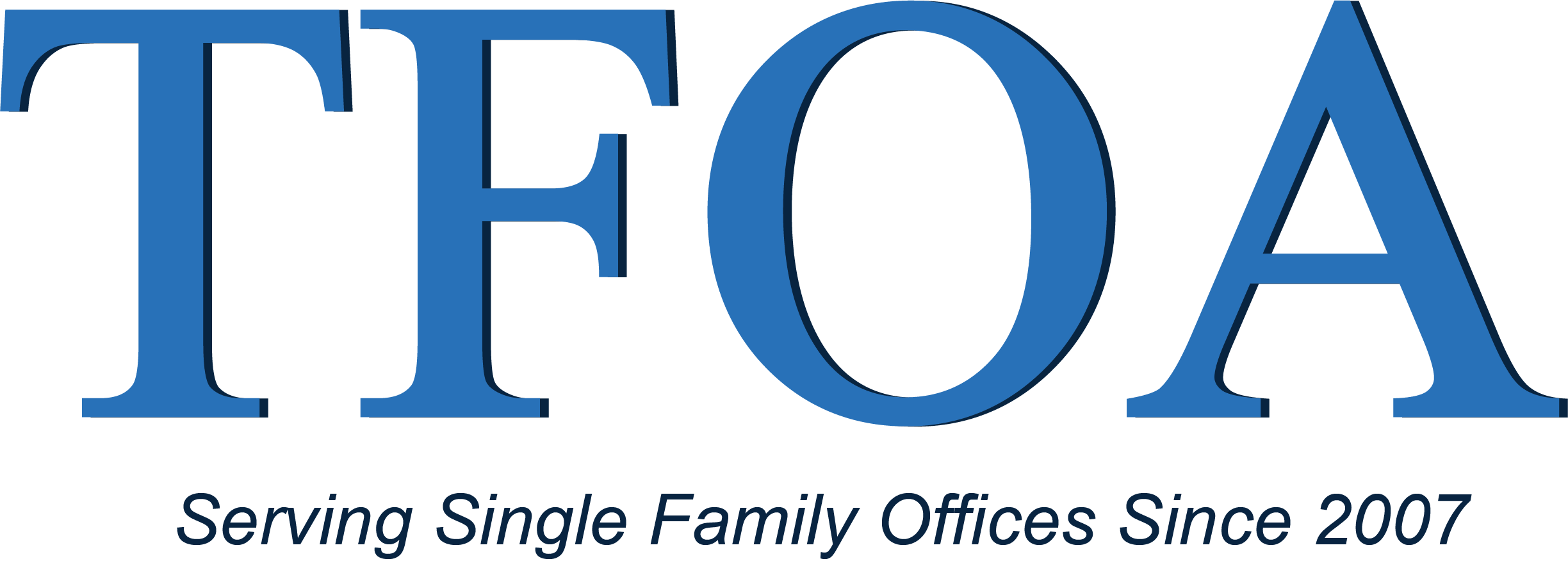Some Thoughts on Single Family Office Technology
Many SFOs fail to invest in the robust technology infrastructure needed to optimize their capabilities, either due to a lack of execution or a lack of awareness around available solutions. Below are the six key technology needs for SFOs, along with a roadmap for the five key activities required for meeting those needs...
Key Technology Needs for SFOs
- General Ledger Accounting: A double-entry accounting system, with workflow and accounting controls, integrated with investment and financial reporting, permits the SFO team to track the inflows and outflows of the family office and related entities.
- Financial Administration: The accounting package should provide for management and payment of all expenses and accounts receivable and payable, ideally, with integration and auto-posting to the general ledger. Automation, along with the appropriate controls (verification and approval workflows), is critical to manage the volume and complexity of transactions that most SFOs face.
- Consolidated Reporting: The accounting package must be capable of providing family members with an aggregated view of their balance sheet, income and cash flows across multiple custodians and financial relationships. The package should also enable robust ad hoc reporting (including risk metrics and performance analytics) on each family member's comprehensive net-worth picture.
- Secure Document Portal: A document vault permits encrypted/secure connectivity and communication among SFO staff, family members and interested parties, along with electronic storage of all family documents (family history, legal agreements, wills, statements, etc.).
- Investment Analytics: An SFO with any degree of in-house CIO function will require portfolio management and trading systems, as well as market data and manager research and due diligence databases.
- Infrastructure and Security: Many SFOs self-host their data and technology solutions (i.e. they have acquired and managed their own IT equipment, software, and processes). However, outsourced providers now offer cloud-based virtual hosting services in highly secure (SAS 70 Level II and ongoing security audit testing certification) and cost-effective hosting environments (with disaster-recovery support). SFOs should consider the cost/benefit and ongoing flexibility of the latest hosting options. SFOs also must consider their IT staff and organization: whether full time IT employees are needed or whether IT support can be adequately outsourced.

How to Meet Technology Needs
SFOs must take a strategic approach to designing, selecting, executing, and maintaining their IT systems and resources. Given IT is a mission critical function for every family office, and the task of developing a strategic plan for IT investment is complex, most SFOs engage a consulting group with specific experience designing IT solutions for SFOs.
- Design: Whether upgrading an existing technology infrastructure or starting from scratch, an SFO needs to begin by assessing its technology needs and requirements, taking into consideration all family members, businesses, investment entities, office staff, and external service providers that must be supported. SFOs are increasingly adopting institutional-like requirements around their IT in terms of mobile and real-time online accessibility, tools for trading, analytics, and research. In particular, SFOs are seeking greater visibility into all their direct and manager fund investments, real-time evaluation of the level of risk (through standard deviation, VaR, etc.) and look throughs on asset class, holding and geographic exposure across investments. They also require monitoring of counterparty relationships and clarity about their global asset allocation at the entity, family, and individual levels. The strategic-planning process will include documenting, confirming and prioritizing needs and requirements, as well as developing due diligence criteria for vetting potential solution providers. For example, the due diligence criteria will likely include insource vs. outsource, buy vs. build, firm size and tenure, security standards, and reference checks. Ultimately, the process will lead to a request for proposal (RFP) and evaluation of service providers who meet the criteria.
- Selection: SFOs have a myriad of options concerning the technology approaches they can take due to the ever-increasing number of vendor solutions to meet the needs of SFOs. Some SFOs opt to leverage and integrate a number of disparate stand-alone vendors. For example, they may use a general ledger from a provider such as Intuit, QuickBooks or Microsoft coupled with a reporting package such as SAP Crystal Reports, firms such as the Google, Amazon or Rackspace for Cloud hosting, financial administration from the bill pay capabilities of their banking relationship, etc. Others leverage a single provider to meet the majority, if not all, of their needs (examples include: Wealth Touch, Archway Technology Partners, and RockiT). Families with more limited current and forecasted needs, who believe they can ably execute and maintain their technology themselves, typically take the former approach. Those who need a more robust and scalable solution are increasingly partnering with single source providers. There are obviously pros and cons to both approaches. SFOs should also be aware that a number of financial institutions have begun developing in-house capabilities or partnering with leading family office technology providers that offer families and SFOs IT solutions and related services such as access to market data and tools to manage risk, analytics and trading. Their technologies may be integrated into the family office's investment management and banking systems or on an à Ia carte basis. These options may be cost-effective for SFOs as they're typically subsidized or simply included for no additional charge as part of the overall service.
- Assessment: When considering multiple solution approaches and providers, it's important to compile detailed cost data in the evaluation process and benchmark the cost projections against peers. When evaluating options, SFOs should select the solution(s) that provide flexibility and scalability for ongoing growth, require limited investment in maintenance and enhancements, and above all, ensure the privacy and security of the data and documents of the family. One of the key objectives and outcomes of the process should be to achieve collective buy-in across the SFO staff and family members who will use the IT system.
- Execution: This phase often creates the greatest challenge for SFOs, making ease-of-implementation a key priority in the selection process. Sufficient resources, including money, time, focus and attention, must be allocated to implementing the chosen solution. Some SFOs have the technical expertise to evaluate and select an in-house integrated solution leveraging multiple software providers, but most find it overly burdensome to implement, configure and customize, integrate, and test the chosen solution. Other SFOs taking the in-house multi-solution approach will engage the software provider's professional-services team or an external IT consultant to implement the chosen IT solution. Using an outside team for implementation can speed up the upfront implementation, but in the maintenance phase it can become very costly over time. Those SFOs that opt to outsource their technology needs via a financial institution or third-party partner will often be able to get up and running more quickly than those that choose a more customized or in house approach. SFOs with relatively uncomplicated reporting needs that they outsource to an external provider may be able to use modular options, or they may choose to take advantage of the provider's con figuration and customization abilities (at additional cost).
- Maintenance: IT costs for SFOs vary widely de pending on their needs, the number of entities, global reach, assets under management, type of assets and liabilities, and the approach they take to the IT environment. The total IT budget will typically include the following:
--Hardware costs.
--Hosting and data management.
--Consulting support throughout the process.
--Professional services configuration and customization of solutions.
--Software license fees and annual maintenance costs (typically a percentage of license fees).
--Outsourced operations fees (typically annual fees based on the complexity of services such as aggregated reporting or financial administration: e.g. number of entities, number of transactions, etc.).
The large majority of SFOs have moderate IT requirements. They can choose a basic general ledger and manually create reports via Excel, while maintaining a small or part-time IT staff. These SFOs typically have annual costs in the $50,000-$150,000 range. However, SFOs that have significant IT requirements often leverage one of the leading family office services-outsource providers (Wealth Touch, Archway Technologies, or RockiT for example), in addition to IT staff and other IT software and infrastructure. They might see total costs of $3 million to
$4 million+, driven largely by the complexity of their balance sheets (the number of entities, alternative investments, transaction, and bill payment flow, etc.), customization needs and geographic dispersion.
On average, based on industry research, anecdotal interviews, and surveys, SFOs can expect to maintain an annual IT cost base (software, operational outsourcing, hardware and hosting fees, and IT staff) of 10-15 bps of their assets under management.
For budgeting purposes, SFOs must consider ongoing upgrades (software and infrastructure), research and development costs, evolving requirements of the office and family members, the pace of change in technology capabilities, and the complexities of IT security and data management. Given these considerations, many SFOs that previously chose to handle IT in-house are increasingly looking to outsource their core IT needs to third-party providers, while maintaining a small IT staff to attend to less complex office and individual family member needs (e.g. property and personal use vehicle connectivity, security, mobile device management, etc.).
A small bit of housekeeping: Please check your spam folder to be sure my personal email marc@tfoatx.com is on your safe senders list. I suspect you might find a few emails there from me over the past year.

All the information provided by TFOA are for informational and educational purposes only and neither purports nor intends to be, specific trading or investment advice or a recommendation to buy or sell any security, fund, or financial instrument. Information should not be considered as an offer or enticement to buy, sell or trade. You should seek appropriate advice from your broker, or licensed investment advisor, before taking any action. Past performance does not guarantee future results. By subscribing as a member to TFOA, you acknowledge and accept that all trading decisions are your own sole responsibility, and TFOA or anybody associated with TFOA cannot be held responsible for any losses that are incurred as a result. The information contained in this electronic mail message, including attachments, if any, is confidential information. It is intended only for the use of the person(s) named above. Internet emails are not necessarily secure. Each recipient is responsible for carrying out such virus and other checks as it considers appropriate to ensure that the receipt, opening, use or onward transmission of this message and any attachments will not adversely affect its systems or data.
